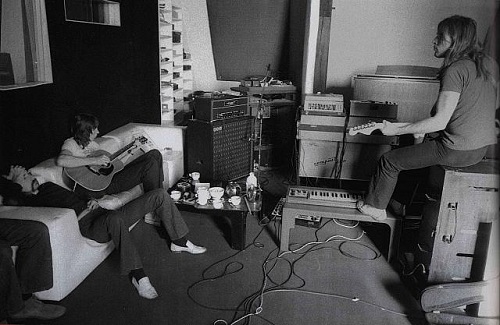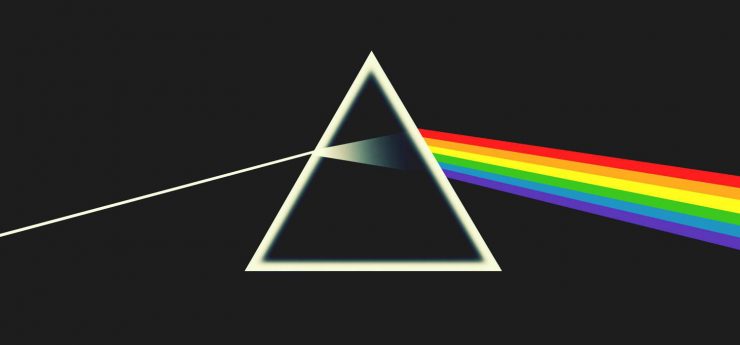By: Lucas de Lima
What can music be? Why is music so difficult to perfect? Where is the end of the never-ending boundaries of music creation? How can one create the greatest album of all time?
These questions were probably asked by the members of legendary progressive rock band Pink Floyd when they created their 1973 magnum opus album, The Dark Side of the Moon.
Following their formation in 1965, Pink Floyd had created seven studio albums, including a soundtrack to a film. Their original leader, Syd Barrett, had been expelled from the group for erratic behavior and a consistent drug problem. They had success, but never enough to outshadow fellow British acts of the 1960s such as The Beatles and The Rolling Stones.
Pink Floyd needed a breakthrough. An album that would send their band into the stratosphere of popular music for many years to come. An album that would allow them to be remembered by multiple generations of music fans.
The Dark Side of the Moon is that album for Pink Floyd. After over 8 months of recording, it was released on March 1, 1973. The album was received to immediate commercial success, and eventually became the longest running album on the Billboard 200 albums chart. The album lasted 736 non consecutive weeks on the Billboard 200. Another surprising fact is that 1 in every 14 people below the age of 50 is estimated to have a copy, or have owned a copy, of The Dark Side of the Moon in their lifetime.
But no ordinary album just catapults itself to immortality whilst having an average tracklist. Dark Side is known for having one of the most concise, smooth-flowing tracklists of any album ever created.
It begins with a heartbeat. A slow, thumping noise that starts the opener, “Speak to Me.” Other than some other random voice clips, Speak to Me mostly serves as an interlude for the real start of the album, “Breathe (In the Air).” This song is sung by guitarist David Gilmour, who speaks about the beginning of life. The song can be used as a comparison to the start of life itself, like a baby taking its first breaths. In the opening lines, Gilmour states, “Don’t be afraid to care.” With such an enduring yet quick opener as “Breathe (In the Air),” it’s hard not to care.
“Breathe (In the Air)” segways into the first true instrumental piece on the album, “On the Run.” A heavy breathing commences with a man running through an airport terminal. Various sounds can be heard like heavy synthesizers and voices over an intercom. This track represents the fast start of life, with humans having to learn the world around them at a young age and at a fast pace in order to get a grasp of their surroundings. After the nervous wreck of the man’s footsteps ends, “Time” arrives.

“Time” is the longest track on side A of Dark Side. Lasting 6 minutes and 53 seconds, the song is a suite of emotions and is one of the highlights of the album. The song begins with what feels like a million alarm clocks going off at the same time, which eludes into an extended introduction with drummer Nick Mason playing a rototom(a type of drum) and bassist Roger Waters playing a “tick-tock” sound until all sounds meet together to lead into David Gilmour’s first verse. Keyboardist Richard Wright joins Gilmour for the bridge, which includes thoughtful lyrics about the speed of life, and the issue of when you “never seem to find the time.” The song ends with a reprise of “Breathe (In the Air)” with a new set of lyrics, and right as Gilmour ends his last verse, the menacing piano of “The Great Gig in the Sky” begins.
Mostly an instrumental, the only vocals present are that of Clare Torry, who sings a wordless vocal epic across the entirety of the song. Wright opens the song with a piano chord progression that emulates Ludwig van Beethoven’s Piano Sonata No. 14, more popularly known as “Moonlight Sonata.” While lasting only 4 minutes and 36 seconds, The Great Gig in the Sky packs an emotional punch that finishes up side A of The Dark Side of the Moon in an utterly beautiful manner.
Side B of The Dark Side of the Moon starts off on a different note, a bank note perhaps. The chimes of coins, cash registers, and rips of paper currency begin the song, “Money.” “Money” is the most popular song from the album. The iconic bass line has been ranked among the most recognizable bass lines of all time. The lyrics discuss the stigma around the pursuit of money, saying how “it’s a crime” but “don’t take a slice of my pie.” Pink Floyd is trying to demonstrate how money is a desired asset in anyone’s life, but acquiring it can sometimes involve crimeful actions. This track is a bit of a departure from Dark Side’s themes of insanity and the human condition, but it still has its place due to the large part that money has in every person’s life journey.
The following song is the longest on the album, but it doesn’t waste a single second of its welcome. “Us and Them” is a trip to say the least. The mysteriously fading vocals and a stinging saxophone solo would be the highlight of any other song, but the chorus is what makes the song so special. Its peaking vocal harmonies and booming drums overpower the message that Gilmour tries to speak through, but we can certainly feel it through the music. “Us and Them” is an experience everyone should experience, at the very least, once in their lifetime.
“Any Colour You Like” is the next track, and the third and last instrumental piece on Dark Side. Gilmour’s funky guitar riff allows Wright’s keyboards, Mason’s drums, and Water’s bass to soar on an awesome jam for 3 minutes and 26 seconds.
The last 5 minutes and 58 seconds of Dark Side are often combined on releases into one singular song, due to the joint nature of the two records. “Brain Damage” and “Eclipse” are the climax of the album. This is where all the themes of the album come into play at their strongest moment on the album. “Brain Damage” is about the mental breakdown that former band member Syd Barrett experienced, leading to his departure from the band. Barrett became drug-dependent, and couldn’t function correctly during concerts and performances.
His departure in 1968 marked a new era for Pink Floyd, recruiting Gilmour as guitarist and his replacement. The lyrics, written by Waters, detail the demise that Barrett underwent. How Barrett disoriented his life too soon, and lost control of his musical abilities right in the middle of his prime. The lyrics also talk about an additional voice inside of Barrett’s head, possibly causing him to act oddly and far from his normal self.
In “Brain Damage” is also the first time throughout the entire album that the literal words, “The Dark Side of the Moon,” are spoken. The line is included in the glorious chorus with the backing vocals of Torry, and all of the band members performing in a simultaneous and epic fashion. “Brain Damage” is almost the full circle moment of the album, but the next track is where the journey ends.
“Eclipse” is the final phase of The Dark Side of the Moon. Its short 2 minute length ends the album on a quick burst of energy and emotion. The lyrics work in a repetitive fashion, with Waters repeating the phrases “All that you” and “All you,” followed by a simple and daily task that all humans do. For example, “All that you give” and “All you create.” Waters does this to show that all of the actions that we do everyday, from minuscule tasks and large decisions, will end up being what becomes the experience of our lifetime.
The Dark Side of the Moon has everything that an album requires to be excellent. A memorable cover, a concise tracklist, a decent length, and stellar songs and songwriting. It checks all of the boxes to be the greatest album experience of all time. The feelings you get listening to The Dark Side of the Moon you can not find anywhere else. But if there was another album, why would you need to look further than The Dark Side of the Moon?
Tags: album review rhs, dark side of the moon review, pink floyd review, rangers, Redwood, redwood gigantea, redwood high school, redwood journalism, redwood music, redwood rangers, rhs, visalia ca



